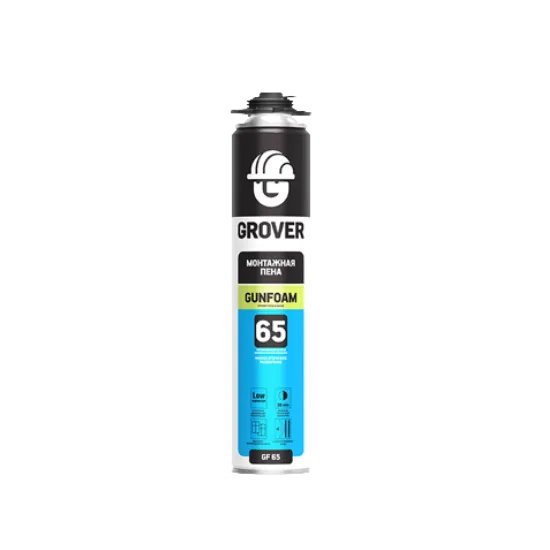Grover
GF65
- No structural deformation
- High productivity
- Primary processing time 30 minutes
- Noise absorption 60 dB
- Volume 840 ml

Properties Professional assembly foam - All-season (from -10°C to +30°C). - Hardens under the influence of air humidity. - Has a homogeneous fine-pored structure and excellent adhesion to most typical building materials. - Provides excellent heat and sound insulation. - Resistant to moisture and mold. - Withstands high mechanical loads. - Has low secondary expansion - does not deform structures. - Cured foam can be cut, plastered, painted and wallpapered. - Output of finished foam 65 l - Volume 840 ml Purpose - Installation and sealing of door and window blocks. - Filling, sealing and sealing of gaps, seams, voids, cracks. - Fixing pipes in passages. - Installation of sound and heat insulation screens. - For interior and exterior work. - For rooms with high humidity. - Heat resistance in hardened form: from -40°C to +90°C.
Secondary expansion up to 33%
Primary treatment 30-40 minutes
Full hardening in the joint (+23 °C) up to 12 hours
Full hardening in the joint (+5 °C) up to 24 hours
Preparation for work
The best performance when working with foam is achieved if the temperature of the can is 20°C.
If the foam was stored at a lower temperature, the can must be kept at room temperature for at least 12 hours (store the can in a vertical position, with the valve upwards).
Shake the can thoroughly (20-30 times) immediately before use. The surfaces must be solid and clean. Pre-wetting the surface provides a better result.
Application
Remove the protective cap and screw the can to the gun. The working position of the can is bottom up. The foam output speed is regulated by pressing the gun trigger. The output volume is regulated by the screw on the gun. The used can must be replaced quickly so that the foam does not harden inside the gun. It is recommended to fill vertical joints from the bottom up to 70% of the depth (as professional foam will increase in volume by approximately 30% depending on environmental conditions).
Further processing
The hardened foam can be cut, plastered, painted and wallpapered. Polyurethane foams are sensitive to UV radiation. If the joint is left unprotected, the foam will collapse.
Cleaning tools
To flush the gun and clean surfaces from uncured foam, use GROVER CLEANER. Drops of hardened foam can be removed with GROVER REMOVER or mechanically.
Polyurethane polymer, diphenylmethane-4,4-diisocyanate, propane, butane, tris (2-chloro-isopropyl) - phosphate, dimethyl ether, alkanes
Precautions
Conventional assembly foam contains isocyanates, which can cause hypersensitivity and irritate the eyes and skin if inhaled. The concentration of isocyanates in the foam is very low and usually does not affect health, but for prolonged work with foam, sufficient ventilation of the room should be ensured. Since the cylinder is under pressure and is flammable, the foam should be protected from overheating and stored away from sources of ignition, avoid direct sunlight and smoking during work.
Disposal
Do not burn or puncture the cylinder (even empty)! Throw the used cylinder in a waste container.





